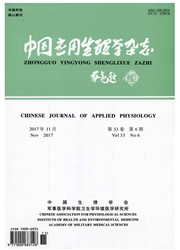

 中文摘要:
中文摘要:
目的:探讨一氧化氮(NO)对大鼠LI/R后肾脏P-选择素表达的影响及意义。方法:采用本室常规方法复制大鼠LI/R模型。将大鼠随机分为四组:对照组,LI/R组,L—Arg组和L-NAME组。观察肢体缺血4h再灌注4h后各组动物血浆NO及肌酐(Cr)、尿素氮(BUN)的变化;观察肾组织NO、髓过氧化物酶(MPO)、总一氧化氮合酶(tNOS)、诱导型一氧化氮合酶(iNOS)、结构型一氧化氮合酶(cNOS)的改变;测定尿蛋白含量、利用聚丙烯酰胺凝胶电泳法检测尿蛋白性质;免疫组织化学方法检测肾组织P-选择素(P—selectin)的蛋白表达,结合自动图象分析系统对其结果进行定量分析;肾组织切片经六氨银染色在光镜下观察其形态学改变。结果:与control组比较.LI/R组大鼠血浆NO、BUN、Cr均明显升高;肾组织MPO、NO、tNOS、iNOS均明显增加,而cNOS明显下降;尿蛋白含量增多,电泳显示,有大分子量蛋白排出;光镜下可见肾小管上皮细胞水肿,有炎细胞浸润:免疫组化结果显示:P-selectin蛋白表达明显较control组增强。与LI/R组相比,L-Arg组各项损伤指标明显减轻;肾组织P—selectin蛋白表达明显减弱;L-NAME组血浆和肾组织各项损伤指标明显加重;肾组织P—selectin蛋白表达明显增加。结论:大鼠LI/R后急性肾损伤的发生可能与P—selectin的表达有关;NO可能通过减弱P-selectin的表达及中性粒细胞的浸润,减轻LI/R后肾脏组织形态学及肾功能的损伤性变化。
 英文摘要:
英文摘要:
To probe into the affection and significance of NO on the expression of P-selectin in renal injury following hind limb ischemia/reperfusion in rats. Methods: In accordance with the conventional approaches of our department, the model rats were prepared after they were made to undergo 4 hours or ischemia followed by 4 houes of reperfusion of hind limbs. The Wister rats were divided into four groups randomly: Control group, LI/R group, L-Arg group and L-NAME group. And then in those four groups of Wister rats, a series of values of measurement were determined such as: Plasma concentrations of nitric oxide(NO), blood urea nitrogen(BUN) and creatinine(Cr). Furthermore, biochemically there came to the assessment of the values including myeloperoxide (MPO), NO, total nitric oxide synthase(tNOS), inducible NOS(iNOS) and constitutive NOS(cNOS) of renal tissue in different groups. By the methods of electrophoresis and biochemistry, the urine protein was mensurated. The immunohistochemical method was used to detect the expression of P-selectin protein. The morphologic changes were observed with a microscope.Results: After hind limbs had suffered from ischemia/reperfusion for 4 hours, there was the occurrence of a series of results such as in the following which were based on the comparison between plasm of LI/R group and control group. The values of NO, BUN and Cr increased significantly, and the trend of indexes such as NO in renal tissue was similar to that in plasma. The values of MPO, tNOS and iNOS in renal tissue all increased significantly after reperfusion, while eNOS decreased distinctly. The urine protein appeared, especially large molecular weight protein. Renal pathology revealed that after LI/R there were edema and infiltration of polymorphonuclear nutrophil (PMN). Immunohistochemically, the expression of P-selectin was upregulated significantly. Compared with LI/R rats, all injury changes were alleviated in L-Arg group. Morphologic changes were mild. Both the content of
 同期刊论文项目
同期刊论文项目
 同项目期刊论文
同项目期刊论文
 期刊信息
期刊信息
